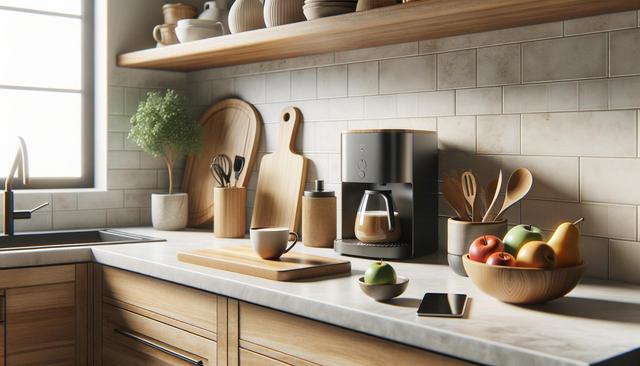Why Granite Is Losing Its Grip on Modern Kitchens
Granite has long been a go-to material for kitchen countertops, admired for its durability and natural stone appearance. However, changing design preferences and evolving lifestyles are calling for something different. Homeowners are beginning to look beyond granite for options that offer a wider variety of colors, textures, and sustainability benefits. The latest countertop trend is stepping in to meet these demands, offering a compelling alternative that’s quickly gaining traction in modern kitchen design.
While granite still has its place, it does come with certain limitations. For instance, it requires periodic sealing to maintain its stain resistance and can be prone to cracking under extreme temperature changes. Additionally, the natural variations in granite may not appeal to homeowners seeking a more uniform or contemporary look. These factors are driving the appeal of newer materials that provide similar durability but with added aesthetic and practical benefits.
Quartz Surfaces: A Rising Star in Kitchen Design
Among the materials making waves in the market, engineered quartz surfaces are becoming a standout choice. These countertops are composed of natural quartz crystals blended with resins and pigments, offering a multitude of design options while maintaining impressive durability. Quartz countertops are non-porous, making them highly resistant to staining and bacteria—an important consideration for busy family kitchens.
What sets quartz apart from granite is its consistency in appearance. This allows homeowners to achieve a cleaner, more polished look that fits seamlessly into modern and minimalist kitchen styles. Additionally, quartz does not require sealing, reducing maintenance and enhancing convenience. Some of the key benefits of quartz surfaces include:
- Wide variety of color and pattern options
- Consistent and sleek appearance
- Low maintenance and easy to clean
- Durability comparable to natural stone
These features make quartz a practical and stylish option for those looking to refresh their kitchen with a modern touch.
Sustainability and Eco-Friendly Countertop Choices
Another factor contributing to the shift away from granite is the growing emphasis on sustainability in home improvement projects. Eco-conscious homeowners are opting for countertop materials that minimize environmental impact. This includes recycled surfaces made from a mix of glass, porcelain, and paper composites. These materials are not only environmentally friendly but also offer unique visual interest and texture.
Quartz countertops also score well on sustainability, especially when manufactured using environmentally responsible methods. Some brands focus on reducing water usage, repurposing waste materials, and minimizing carbon emissions during production. For those prioritizing green living, the new wave of countertops aligns well with eco-friendly home goals.
Incorporating sustainable materials into kitchen design doesn’t mean sacrificing style or functionality. Many of these options offer bold colors, matte finishes, and interesting textures that can enhance the overall aesthetic of a kitchen while supporting responsible consumer choices.
Design Flexibility and Customization Options
One of the reasons the new countertop trend is gaining popularity is the level of design flexibility it offers. Unlike granite, which is limited to natural stone’s inherent patterns, engineered surfaces like quartz can be customized to suit a wide range of design themes—from industrial chic to coastal airy. This flexibility allows homeowners and designers to create cohesive looks that extend beyond traditional stone textures.
Popular design choices for quartz and other modern materials include:
- Waterfall edges for a sleek, continuous look
- Integrated sinks for seamless functionality
- Matte finishes that reduce glare and enhance sophistication
- Bold color choices, including black, navy, and even soft pastels
This ability to personalize countertops makes them a favorite among designers and homeowners seeking to express their unique style while maintaining long-term value and practicality.
Cost Considerations and Long-Term Value
While granite has traditionally been viewed as a premium kitchen upgrade, the new generation of countertop materials offers a competitive edge in both cost-efficiency and return on investment. Quartz surfaces, for example, often fall within a similar price range as high-end granite but require less upkeep over time, which can lead to savings in maintenance and repairs.
Additionally, because of their durability and aesthetic appeal, modern countertop materials can contribute to increased home value. Their resistance to staining and chipping makes them a reliable choice that can stand up to the demands of daily life. When considering the total cost of ownership—including maintenance, longevity, and resale potential—these emerging materials present a strong case for homeowners looking to balance style and practicality.
Ultimately, choosing the right countertop comes down to aligning material characteristics with personal preferences and lifestyle needs. With the growing availability of innovative options, there’s no shortage of ways to elevate kitchen design beyond the traditional granite standard.
Conclusion: A New Era for Kitchen Countertops
As kitchen design continues to evolve, so do the materials that define its core elements. The move away from granite in favor of more adaptable, low-maintenance, and visually versatile surfaces marks a significant shift in homeowner preferences. Whether you’re planning a full kitchen renovation or a simple countertop upgrade, exploring these new materials can lead to a space that’s both functional and visually compelling. With so many high-quality options now available, the modern kitchen is poised to reflect not just changing trends but also the diverse lifestyles and values of today’s households.






